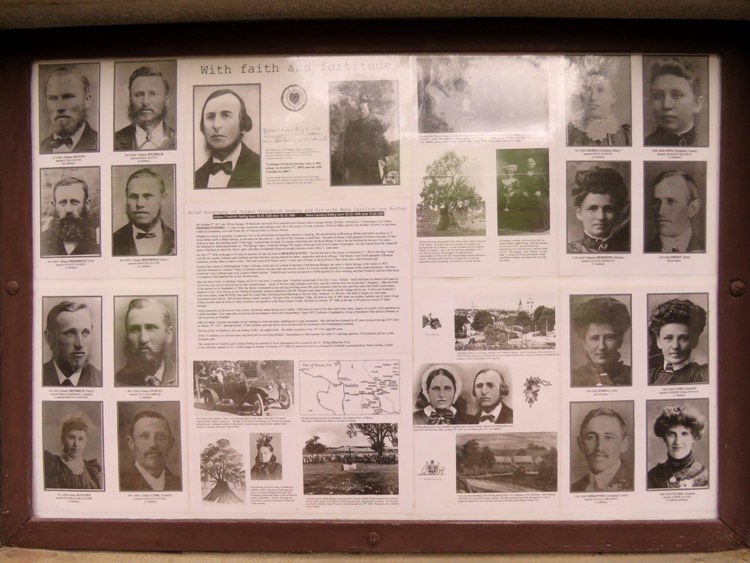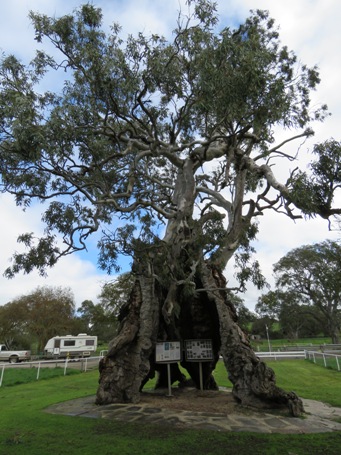Australia So Much to See
A family tree at Springton, Mount Pleasant to Williamstown
Springton was once known as Black Springs. In the 1846s, a good source of spring water was discovered in an area previously blackened
by bushfires, so the name Black Springs stayed until it became known as Springton around 1862. The town was officially surveyed
in 1856.
As a successful farmer, he eventually owned 1,000 acres (400 hectares) of land. In 1858 at the age of 30, he married 18 year old Caroline Rattey and she lived with him in this tree. Caroline had arrived from Germany a year later than Frederick. Their first child was born in the tree house, but soon after the arrival of their second child, they moved into a small two roomed pine and pug cottage they constructed nearby. Four years later, they constructed a stone cottage adjacent to the timber cottage. This is still used as a dwelling.
Leaving Springton, we drove to nearby Mount Pleasant, where there is a showground caravan park which is very popular. This showground
hosts one of the largest rural shows in South Australia each March. # This is the closest fully serviced showground camping
to Adelaide, which is only 55 kilometres away.
Mount Pleasant comprises three areas; Totness, Talunga and Hendryton Mount Pleasant township was developed by Henry Glover, and surveyed in 1856
The first European explorers through the Mount Pleasant
district were Dr George Imlay and John Hill in January 1838. Settlers moved into the area in the late 1830s with flocks of sheep and
with bags of grain.
Theories about how the area was named. Mrs. George Phillis named a small hill “Mount Pleasant”; from
that the township derived its name. The name was taken from that used by James Phillis, who had come from an area near Eastry
in Kent. The land had reminded him of his homeland. His sister was named Pleasant, who may also have inspired the name. It is known
that by the 1840s there was a Mount Pleasant on the property owned by James Phillis and it had been named by Mrs George Phillis. James
Phillis, Henry Giles and George Melrose all held pastoral leases in 1844.
Frederick Herbig was a prominent citizen in the community and the Lutheran church. Sadly, he died at the age of 58 as a result
of an accident, leaving Caroline, who had never learned to speak English nor able to read and write, to bring up their family. Her youngest child was only fifteen months old. Caroline lived to the age of 87.
Five descendent families still live in
the Springton area.
Springton now has little more than houses, a primary school, a hotel and several wineries,
plus a small shop which also acts as an Australia Post agency. There is also a vehicle and farm machinery mechanic in Springton.
From Mount Pleasant, we turned north through the Mount Crawford State Forests, which are mainly pine plantations. Two campgrounds
are detailed under camping.
Shortly after passing the Mount Crawford Forest Information Centre, we crossed part of the Warren
Reservoir, then drove alongside it for over a kilometre. Warren Reservoir, damming the South Para River was built during World
War One in 1914 to 1918, with a capacity of 4.7 gigalitres.
It was built to ensure water supply to the local area. When
the natural springs supplying Eudunda dried up every summer, Warren Reservoir was built to ensure a reliable water supply for the
local area.
Areas of the reservoir are open to the public for recreation, with kayaking an canoeing allowed, and recreational
fishing (with permit).
Having crossed the South Mount Lofty Ranges near Mount Crawford in the Mount Crawford forests, we descended into Williamstown which
is quite a large town.
On the edge of the Barossa region, Williamstown has a mixed farming and vineyards. Once a timber industry centre, the two main mills closed in 1990, leaving only A J M & J C Wilson milling softwoods and hardwoods
in the town.
In the early 1840s Thomas Adams moved into the area and called it Victoria Creek, after the creek that flowed
through the area, but Adams was unimpressed with the land and sold his holding for a mob of horses.
Lewis Johnstone acquired
the land and cut it into allotments. He named the small town after his eldest son, William and named Elizabeth Street after his wife. The town was laid out by Johnstone in 1858.


Resources
Mount Pleasant, Talunga Oval (Mount Pleasant Showground) $10 per person per night. Fully serviced sites, laundry, dump point. # Closed for
upgrades August 2022 and reopened August 2023.
Mount Crawford Forest
Rocky Paddock, pit toilets, $5 per person per night,
self registration at Mount Crawford Forest Information Centre located on Warren Road, campground is a short drive from the Centre
on Warren Road. No camping during summer months, and campground may be periodically closed due to logging operations.
Chalk’s Campground, $5 per person per night, self registration at Mount Crawford Forest Information Centre located on Warren Road,
campground is a short drive from the Centre on Warren Road. No camping during summer months, and campground may be periodically
closed due to logging operations.
Williamstown, caravan park $31 powered, $26 for two. Fully serviced, dump point
Although the large centre of Gawler is only eighteen kilometres away, on the way we passed through another town, the tiny Cockatoo Valley. There is a general store, which also serves as a fuel outlet, plus is an Australia Post agency.
Named in
March 1838 when an exploration party comprising John Hill, William Wood, Charles Willis, and John Oakden camped there on the first
overland expedition from Adelaide to reach the River Murray at present Morgan. Oakden reported that the valley was 'swarming with
cockatoos (Corellas), seven of which were shot' to roast for supper. They camped there at 'a rivulet' they had discovered, later
named Yettie Creek.